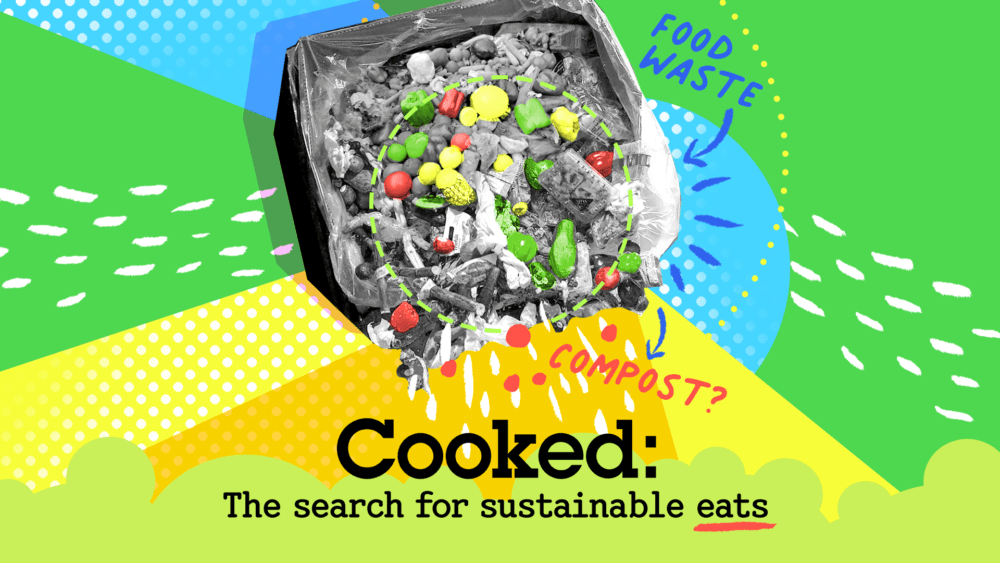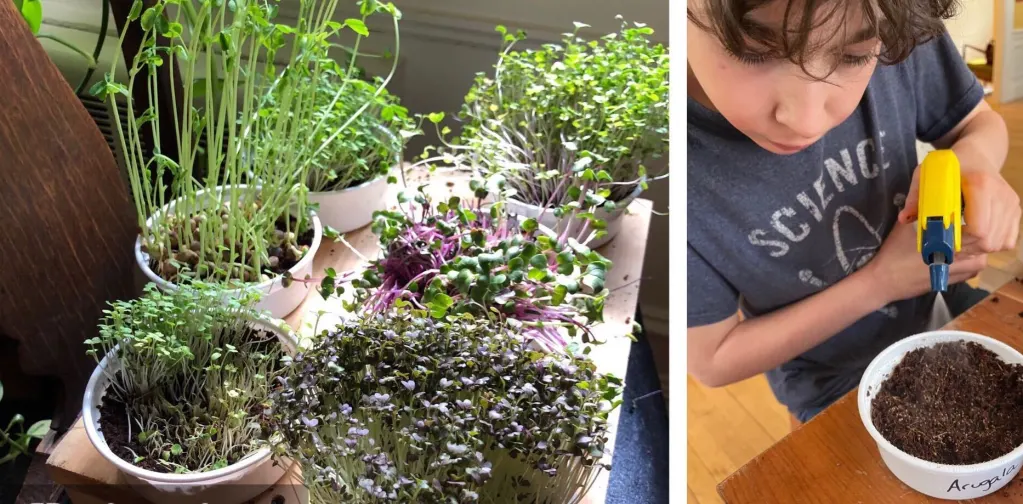Advertisement
Cooked: How can I throw away less food?

This is an excerpt from WBUR's Cooked newsletter. Sign up to understand how to reduce your impact on climate change and take actionable steps so YOU can make a difference.
It’s not every day a conversation about breakfast cereal changes your life.
I was talking to Mei and Irene Li about food waste. The two siblings, along with their older brother, Andy, founded Boston’s Mei Mei restaurant in 2012, which closed in 2020. They now run Mei Mei Dumpling Factory in South Boston. Throwing away food has always rankled them. “That’s your money going right into the trash,” said Mei. “If you could actually cook it and eat it, that makes much more sense.”
They started experimenting with scallion scraps, cilantro stems and droopy arugula. And eventually they hit gold, turning those scraps into their famous “Double Awesome,” a scallion pancake breakfast sandwich with local greens pesto.
“There’s a lot of magic in making something out of nothing,” said Irene. “That feeling of empowerment or satisfaction from knowing that you saved something from the trash or the compost, and then you made it into something that people actually like.”

But the Double Awesome isn’t actually Mei's favorite food-waste innovation.
“Every day my kids want cereal in the morning, and every day they leave a good half bowl of cereal on the table when they go to school,” she said.
“So, I started taking the leftover cereal and dumping it into a blender with the frozen fruit from my smoothie bag. And then I blend it all up into a smoothie and sometimes make popsicles, and then I make them eat their cereal later.”
Did you catch that? She makes leftover cereal into popsicles, and her kids eat them.
That is pure Mom Genius.
Mei Li has a whole website full of such food waste magic, and it has changed how I look at scary old food. That ancient cabbage isn’t a hulking reminder of my wasteful ways; now it’s raw material!
Nobody likes throwing food away, right? It’s a waste of money, and it makes you feel bad. Especially with more than 18% of people facing food insecurity in Massachusetts.
Advertisement
I know, I said this is a “no guilt” newsletter, but don't worry, we've got ways to fix this.
We'll have some tips on how to reduce your food waste. But first, it's important to understand how much food gets tossed in the trash. So, let’s dig into some numbers.
The Numbers Tell A Story
- About 35% of food produced in the U.S. is never eaten. Only China and India generate more total food waste than us.
- The amount of energy it takes to make and dispose of America’s wasted food is equivalent to the annual CO2 emissions of 42 coal-fired power plants.
- About a quarter to a third of wasted food comes from people’s homes. This makes households the largest producers of food waste in the country.
- Massachusetts does slightly better than the national average, with food waste making up 21.5% of our trash.
- A majority of Americans (56%) say they never compost food waste.
- The average American household generates more than 300 pounds of food waste each year. That’s more than twice the weight of the heaviest green cabbage ever grown! (Yes, I am haunted by cabbage.)
- Wasting food may increase the carbon footprint of the average American diet by 39%.
- America has a goal to cut food loss and waste in half by 2030. But guess what? Over the last decade or so, per person food loss and waste in the U.S. has increased by 6 to 8%. Meanwhile, Norway has in recent years decreased its per-person food waste by 11%.
Well, I am sick and tired of these Nordic countries kicking our butts at climate-fixing. Let’s stand with Will Ferrell and “crush” Norway together! Let’s go, New England!
THE BIG TAKEAWAY:
We waste a lot of food at home. It's a problem.
But, there are some easy fixes.
10 Tips To Stop Wasting Food
1. Search your fridge before you shop. All the way in the back! Rummage around or “sweep the kitchen” as Edible Boston says, to see how much half-eaten salsa you already have before you run off and buy more.
2. Don’t automatically chuck “expired” food. Smell it first. Those “expiration” or “best by” dates don’t actually tell you when your yogurt is spoiled. So, take a whiff — you’ll know right away if it’s time to part ways with that whey.
3. Plan meals and shop with a list. Otherwise, you’ll come home with a pile of random food that happened to be on sale. Here are some meal planning apps if you need ideas.
4. Grow your own herbs and microgreens. I am a lazy, incompetent gardener, but even I have grown herbs and microgreens (think sprouts) by a window. This saves me a ton of money, prevents me from chucking spoiled herbs and gives me fresh greens all winter. You just need dirt, seeds and some takeout containers.

5. Shop at farmer’s markets. The lettuce you buy from a farmer probably came out of the ground that morning, so it’ll generally stay fresh much longer than supermarket lettuce that's days or weeks old. And if it’s in season, the price is similar. In New England, SNAP clients can use their benefits at some farmer’s markers, farm stands and CSAs. States offering these benefits, like Massachusetts and Vermont, have handy searchable websites. Lettuce celebrate!
6. Store food properly. Apples: in the fridge! Tomatoes: on the counter! (Until they're ripe, at least. Then to the fridge!) You don’t want to buy all that nice food only to watch it dissolve into brown mush. I know it’s a pain, but do it anyway — your future self will thank you. SaveTheFood offers easily-searchable food-specific storage tips.
7. Upcycle your garbage. You can make pesto from carrot tops! Old fruit into bread pudding! SaveTheFood and Food Waste Feast have user-friendly search-by-food websites that show you how to upcycle your wilted basil and bendy carrots. Edible Boston also has some useful tips on turning anything into a fritter or a dumpling.
8. Be like Roz Chast! Ever since Chast’s article about fridge-foraging for dinner — which she calls “fending” and others call “getcheroni” — our family has been fending about once a week. Everyone wins! Including Mother Earth, who doesn’t want your leftover pad thai.
9. Use your freezer. Brown bananas (skins off!) and mushy apples go in a bag for smoothies. Wilted vegetables go in another bag for vegetable stock. And put that stale bread in another bag for bread pudding, casseroles or croutons.
10. When all else fails, compost if you can. If the idea of composting makes you nervous (smelly garbage! rats!), Foodprint has some ideas on how to get started. NPR also has some tips on home composting and what to do if it stinks; and Connecticut Public has this handy video.
